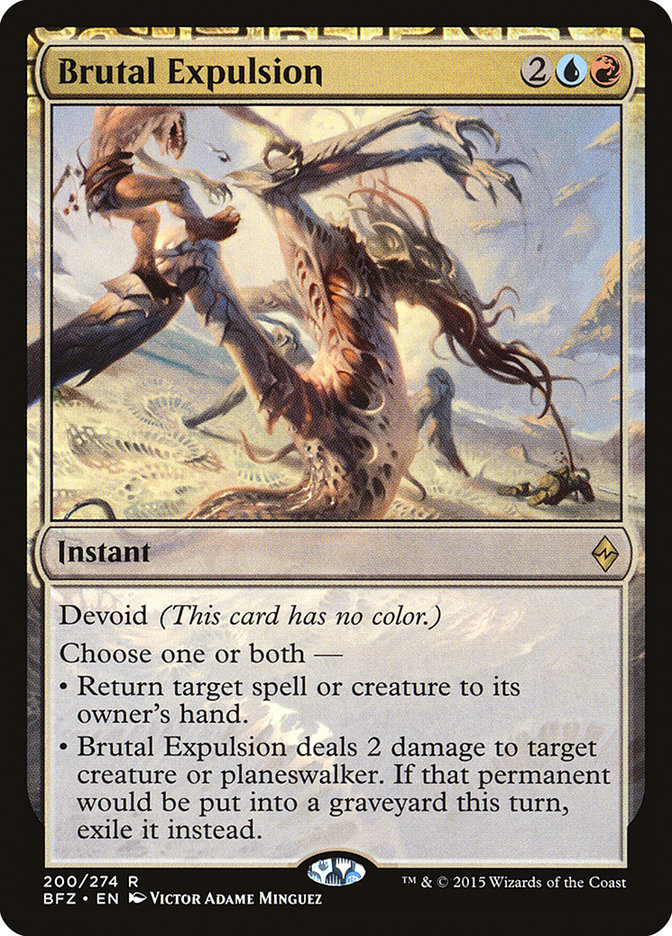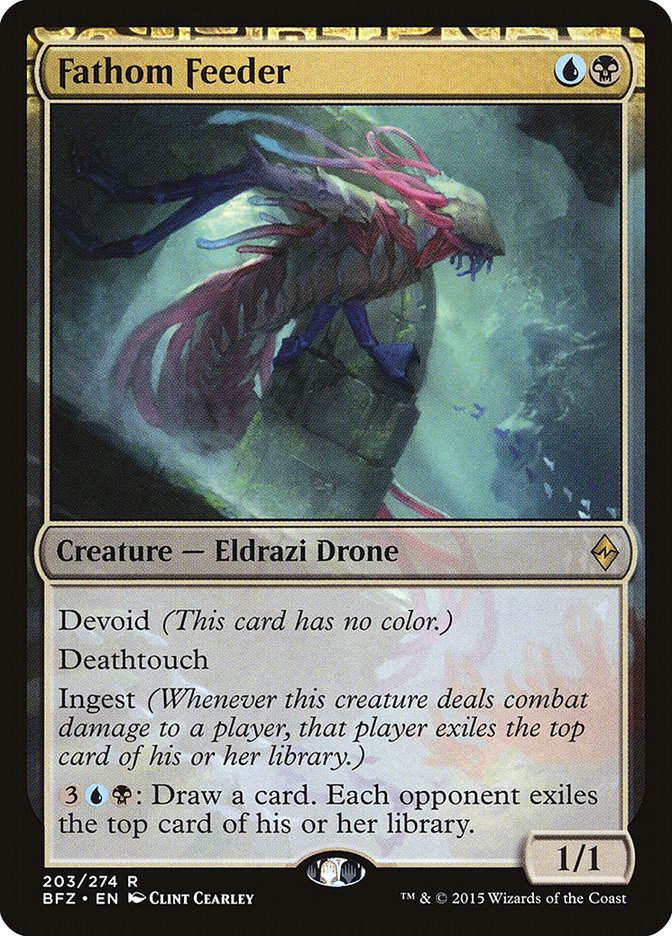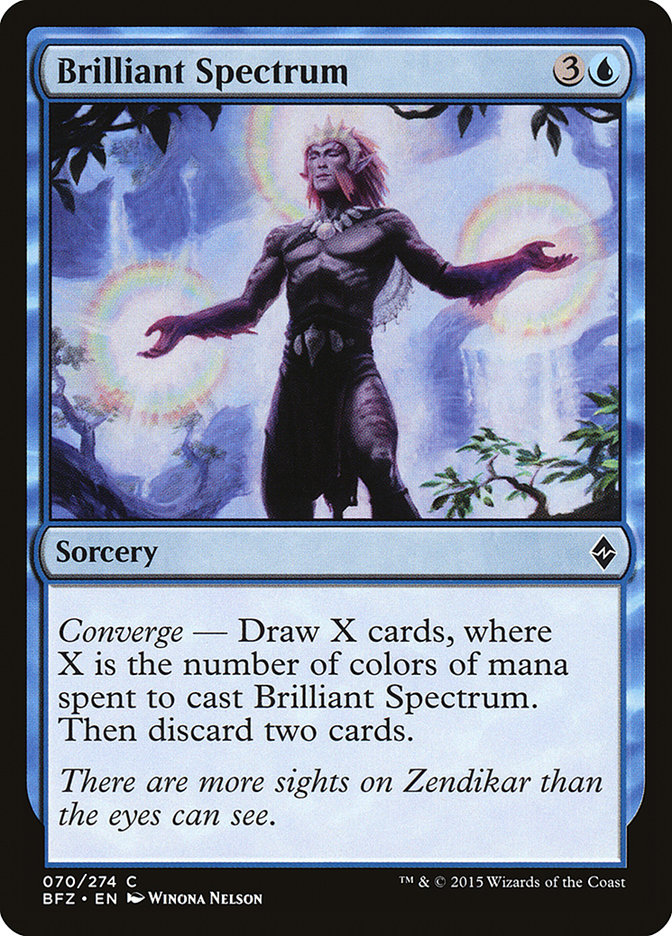Typically it’s my style to identify a few specific cards from the new set and brew with them extensively. In Theros/Khans Standard this wasn’t
terribly difficult, as near the end of the format it was merely a matter of slotting some new toys into pre-existing shells. While occasionally there were
times where build-around-me cards required extensive dedication – Demonic Pact comes to mind – the limitations of manabases and the
requirement to play certain “packages” of the best cards (Siege Rhino and Abzan Charm in Abzan for example) to remain competitive despite whatever cool
things we might be doing in the meantime is a real hindrance.
Battle for Zendikar
has thrown that all out the window. We can do whatever we want, and I’ve been doing precisely that.
However, before I bludgeon you with brews, let’s take a look at the stock decks that I’ve been playing against. These decks with similar cards and
conceptions are the first things you need to worry about beating at the Open Series in Indianapolis this weekend. If I didn’t at least remain competitive
with them, I moved on to working on other decks.
Creatures (19)
Planeswalkers (4)
Lands (26)
Spells (11)

Creatures (18)
- 4 Monastery Swiftspear
- 2 Goblin Heelcutter
- 4 Lightning Berserker
- 4 Zurgo Bellstriker
- 4 Abbot of Keral Keep
Lands (21)
Spells (21)
- 4 Dragon Fodder
- 4 Hordeling Outburst
- 1 Become Immense
- 4 Wild Slash
- 4 Atarka's Command
- 4 Exquisite Firecraft
Sideboard

Creatures (6)
Planeswalkers (1)
Lands (27)
Spells (26)

These three decks represent all three corners of the spectrum – Aggro, Midrange, and Control – and are relatively easy to create functional lists for.
Their core gameplans have all survived the transition into a new format. Jeskai Aggro was a part of this rotation for a while until we figured out all our
lists stunk. While seemingly having many of the tools that it had in the previous format, Jeskai has a variety of problems including an awkward manabase
with no access to a creature-land, it has huge problems with dealing with Gideon, Ally of Zendikar, and it has difficultly beating Abzan in general. I’m
not saying the color combination is unplayable, but rather stating that I’m not happy with any of the directions so far taken with the deck.
But enough about stock decks. On to the brews!
Ramp Decks
Creatures (19)
- 4 Rattleclaw Mystic
- 4 Whisperer of the Wilds
- 4 Dragonlord Atarka
- 2 Dragonlord Dromoka
- 1 Nissa, Vastwood Seer
- 4 Ulamog, the Ceaseless Hunger
Planeswalkers (3)
Lands (24)
Spells (14)
Sideboard

Creatures (6)
Planeswalkers (4)
Lands (27)
Spells (23)

I feel that Green Eldrazi has legs, while the blue version is far less reliable and vulnerable to being broken up should its acceleration be interacted
with. Despite the fact that blue has access to counterspells, where Horribly Awry actually overperformed, I would stick with green ramp decks, which are
actually excellent at beating up on slower midrange decks that are interested in grinding out value rather than ending the game quickly. As one might
expect, it’s hard to compete in the lategame with Ulamog, the Ceaseless Hunger, and thanks to Shrine of the Forsaken Gods, getting there isn’t actually
terribly difficult.
Creatures (6)
Planeswalkers (2)
Lands (25)
Spells (27)

This is another ramp deck, based off of a list by Kenji Tsumura from the previous Standard format. Here, rather than “simply” attempting to resolve a
ten-mana spell, our goal is to build up a large permanent advantage on our opponent, often using Demonic Pact, before “resetting the game,” hopefully at a
much more favorable boardstate. Retreat to Kazandu pulls a lot of weight in this deck by not only keeping you alive long enough to play your Sway of the
Stars impersonation but you often will find yourself with several fetchlands on the battlefield post-Aurora, where it is easy to get the Retreat down and
crack them all to keep out of range.
Blighted Woodland is one of the cards that impressed me the most in this list in particular, and I hope to find places in other decks for it, even if they
aren’t interested in being dedicated ramp decks.
Off-Beat Dragon Decks
Creatures (12)
- 1 Silumgar, the Drifting Death
- 2 Dragonlord Silumgar
- 3 Icefall Regent
- 4 Hangarback Walker
- 2 Fathom Feeder
Planeswalkers (1)
Lands (27)
Spells (20)

Creatures (9)
Lands (27)
Spells (24)

In testing with various Esper Dragons shells, two things became very apparent to me: One is that even more so than before, I wanted my Dragons decks to be
more tempo oriented. Two is that Hangarback Walker is a real pain. While Stasis Snare is a pretty good answer to Hangarback Walker itself, it shifts your
entire deck into a specific direction because of how difficult it is to play XX mana costs. Battle for Zendikar heavily encourages XY
requirements, but the former are far more difficult.
Brutal Expulsion, that’s your cue.
No longer can midrange decks sit on Hangarback Walker and brick your entire strategy. The other major implication once you have a reliable and powerful way
to beat up the construct-that-could is that Foul-Tongue Invocation is once again one of the best cards in your deck. Not only are sources of incidental
lifegain huge in tempo/control decks, but it’s another great answer to Siege Rhino.
The first list in this section is actually an experiment without Dragonlord Ojutai. Normally I would scoff at this idea because the Dragonlord is so
incredibly dominant in any game where he is able to connect, but things are different now, and Icefall Regent’s stock has significantly increased. It is
not easy to remove this Dragon at any profit now with Lightning Strike and Bile Blight gone. Ultimate Price is virtually unplayable with the threats that
are currently present. Not only will Icefall Regent tap down your opponent’s Siege Rhino but it will require five mana for them to Abzan Charm it and it
will be another two turns before their Rhino can attack. I talked last week on the importance of tempo in this
format, and the Regent can promise a huge swing.
The second card I want to discuss in Grixis Dragons is Fathom Feeder. This loveable Eldrazi Tentacle thing really pulls a lot of weight even when not in
conjunction with a Processor pay off or Ojutai’s Command. Just being able to block and trade up, especially with Anafenza, the Foremost, is a huge deal.
Further, if it just hangs around on the battlefield, eventually it will start generating advantage all the while allowing you to leave up countermagic.
This card isn’t particularly flashy, but I’ve been happy with it in a lot of my decks.
The other deck is really quite simple. I just want to kill or counter all of my opponent’s things and hit them four times with the Elder Dragon. Expulsion
is great for both keeping the opponent off balance and not allowing Hangarback Walker to get in the way. The mana works because we now live in Battle for Zendikar Standard.
Reanimator Decks
Creatures (12)
Planeswalkers (1)
Lands (24)
Spells (23)
- 4 Murderous Cut
- 3 Treasure Cruise
- 4 Taigam's Scheming
- 2 Valorous Stance
- 2 Reave Soul
- 4 Necromantic Summons
- 4 Brilliant Spectrum
Sideboard

Creatures (8)
Planeswalkers (1)
Lands (26)
Spells (25)

A new card that struck my eye is Emeria Shepherd. Historically, for Reanimator decks to be powerful, they require you to either be able to play a
normalized game or to be incredibly fast and have a target so powerful that your opponent either dies or is locked out of the game.
If the Reanimator player spends a ton of resources only to get their big thing killed, then they will probably lose. Emeria Shepherd mitigates this problem
by immediately allowing you to put another huge thing onto the battlefield. Even if your opponent is able to deal with Dragonlord Atarka or Ugin, the
Spirit Dragon, they have to contend with the fact that the Shepherd can continue to provide value. Should they kill the former, well then they still have
to deal with a giant Dragon that killed their board!
Brilliant Spectrum and Necromantic Summons are just powerful cards. Anyone who played with Careful Consideration should have some respect for the former,
although I feel like the speed of the format encourages you to do something unfair with it; just playing a grindy game up a card or two isn’t worth taking
your whole turn off in a world of Siege Rhinos. Necromantic Summons has never gotten respect, not even what it deserved in Magic Origins Limited!
Further, the fact that Emeria Shepherd will almost always be a 6/6 is absolutely critical for allowing it to brawl with the Rhino menace.
The rest of these decks are basically just piles of removal, so Anafenza, the Foremost is virtually a non-issue, and nothing else can interact with your
gameplan other than countermagic. These decks need a ton of work, but I like the idea of just interacting with my opponent up the curve then dropping the
hammer.
Apparently I build a lot of Esper decks:
Creatures (18)
Planeswalkers (2)
Lands (26)
Spells (14)
Sideboard

Before Pro Tour Magic Origins I built a Heroic deck that was actually rather light on those elements and utilized Jace, Vryn’s Prodigy and Hangarback
Walker to facilitate an actual long game. While I haven’t worked out a lot of the kinks, I see a lot of potential in the prowess mechanic to be the
spiritual successor to that type of aggressive deck. While the protection spells are significantly worse now without Gods Willing or Ajani’s Presence,
Defiant Strike is still excellent, and it’s relatively easy to get a lot of cards in your graveyard to fuel cheap Murderous Cuts and Treasure Cruises
alongside Jace and fetchlands. Further, Monastery Mentor is just a great Magic card and breaks a lot of the common play patterns of the format with decks
often playing a single large threat and then trying to stay ahead of their opponent by removing theirs.
Creatures (15)
Planeswalkers (7)
Lands (26)
Spells (12)

Here’s a fun fact – and one I discovered two days ago – a creature in exile removed by Silkwrap and Stasis Snare is a willing candidate to be processed.
After discovering this, the requirement on Blight Herder looked far more accessible.
While this is really more of a B/W Midrange deck, the way the Battle lands have been printed in Battle for Zendikar make this light blue
splash not only virtually free, but more or less is a requirement to make the mana work anyways. Fathom Feeder is pulling an additional duty here by not
only being a great early play, but should it ever connect, is half of what we need to get our colorless Siege-Gang Commander online.
Despite the fact that this deck is more on the controlling side, we have a lot of hard hitting threats. Further, the mini-token theme in conjunction with
Gideon, Ally of Zendikar and Sorin, Solemn Visitor means that we are capable of turning the corner incredibly quickly. We also have a fair amount of
incidental lifegain between Sorin and Shambling Vent, which I value quite highly in a strategy such as this.
The Emeria Shepherd sub-theme may just be too cute. While I like the idea of being able to quickly ramp it out the turn after playing Blight Herder, it may
just be too independently weak to warrant the slots. Overall though, I like this deck’s curve, great removal and threats, and a lot of incidental grinding
elements without playing tons of expensive cards.
I should also mention briefly how great it is that I get to sideboard Wasteland Strangler in this deck. While it’s not a maindeck card due to its
ineffectiveness against Anafenza and Siege Rhino, it is devastating against any creature deck trying to operate lower on the curve.
For my final deck this week, well, I’m trying out a lot of different things:
Creatures (10)
Lands (26)
Spells (24)
- 2 Disperse
- 1 Utter End
- 2 Murderous Cut
- 2 Disdainful Stroke
- 3 Dig Through Time
- 2 Crux of Fate
- 3 Ojutai's Command
- 2 Silumgar's Command
- 2 Silkwrap
- 4 Demonic Pact
- 1 Ruinous Path
Sideboard

Now before you scoff at the adorable inclusion of Felidar Cub, Simba attacks and blocks! Sometimes there are even Ascendancies and Tutelages running
around! A lot of the numbers are wonky, but Demonic Pact more or less requires you diversify a “normal” removal suite considerably since you need answers
to your own enchantment. A huge boon for Demonic Pact decks is that Disperse is actually pretty solid these days. While you obviously don’t want to be
repeatedly bouncing your opponent’s creatures, the lack of two mana interactive plays these days make the first or even second casting of the card totally
acceptable for letting you get some ground back. Of course, Demonic Pact will easily get you those resources back and then some.
While I’ve covered a lot of different ground today, I’ve barely scratched the surface. That’s not a hyperbolic statement, as you can really do whatever you
want in Battle for Zendikar Standard. I hope I’ve either helped with or inspired some new brews of your own, and let me know what you think or
have been working on so far!




